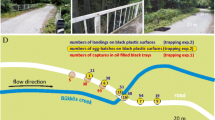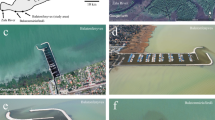Abstract
Based on an earlier observation in the field, we hypothesized that light intensity and horizontally polarized reflected light may strongly influence the flight behaviour of night-active aquatic insects. We assumed that phototaxis and polarotaxis together have a more harmful effect on the dispersal flight of these insects than they would have separately. We tested this hypothesis in a multiple-choice field experiment using horizontal test surfaces laid on the ground. We offered simultaneously the following visual stimuli for aerial aquatic insects: (1) lamplit matte black canvas inducing phototaxis alone, (2) unlit shiny black plastic sheet eliciting polarotaxis alone, (3) lamplit shiny black plastic sheet inducing simultaneously phototaxis and polarotaxis, and (4) unlit matte black canvas as a visually unattractive control. The unlit matte black canvas trapped only a negligible number (13) of water insects. The sum (16,432) of the total numbers of water beetles and bugs captured on the lamplit matte black canvas (7,922) and the unlit shiny black plastic sheet (8,510) was much smaller than the total catch (29,682) caught on the lamplit shiny black plastic sheet. This provides experimental evidence for the synergistic interaction of phototaxis (elicited by the unpolarized direct lamplight) and polarotaxis (induced by the strongly and horizontally polarized plastic-reflected light) in the investigated aquatic insects. Thus, horizontally polarizing artificial lamplit surfaces can function as an effective ecological trap due to this synergism of optical cues, especially in the urban environment.




Similar content being viewed by others
References
Anderson MJ (2001) A new method for non-parametric multivariate analysis of variance. Austral Ecol 26:32–46
Aukema B, Rieger C (ed) (1995) Catalogue of the Heteroptera of the Palearctic Region. Enicocephalomorpha, Dipsocoromorpha, Nepomorpha, Gerromorpha and Leptopodomorpha. Vol. I, The Netherlands: The Netherlands Entomological Society, Amsterdam
Benedek P, Jászai VE (1972) On the migration of Corixidae (Heteroptera) based on light trap data. Acta Zool Acad Sci Hung 19:1–9
Bernáth B, Szedenics G, Molnár G, Kriska G, Horváth G (2001) Visual ecological impact of “shiny black anthropogenic products” on aquatic insects: oil reservoirs and plastic sheets as polarized traps for insects associated with water. Arch Nat Conservat Landsc Res 40:89–109
Bernáth B, Szedenics G, Wildermuth H, Horváth G (2002) How can dragonflies discern bright and dark waters from a distance? The degree of polarization of reflected light as a possible cue for dragonfly habitat selection. Freshwater Biol 47:1707–1719
Bernáth B, Gál J, Horváth G (2004) Why is it worth flying at dusk for aquatic insects? Polarotactic water detection is easiest at low solar elevations. J Exp Biol 207:755–765
Bilton DT, Freeland JR, Okamura B (2001) Dispersal in freshwater invertebrates. Annu Rev Ecol Syst 32:159–181
Boda P, Csabai Z (2009) Seasonal and diel dispersal activity characteristics of Sigara lateralis (Leach, 1817) (Heteroptera: Corixidae) with special emphasis of the possible environmental factors and breeding state. Aquat Insect 31:301–314
Boda P, Csabai Z (2013) When do beetles and bugs fly? A unified scheme for describing seasonal flight behaviour of highly dispersing primary aquatic insects. Hydrobiologia 703:133–147
Choi H, Kim H, Kim JG (2009) Landscape analysis of the effects of artificial lighting around wetland habitats on the giant water bug Lethocerus deyrollei in Jeju Island. J Ecol Field Biol 32:83–86
Csabai Z (2000) Vízibogarak kishatározója I. (Coleoptera: Haliplidae, Hygrobiidae, Dytiscidae, Noteridae, Gyrinidae). [A guide for the identification of water beetles of Hungary, I. (in Hungarian with English abstract)]. Budapest, In: Vízi Természet- és Környezetvédelem 15., Környezetgazdálkodási Intézet
Csabai Z (2003) Vízibogarak kishatározója III. (Kiegészítő kötet) [A guide for the identification of water beetles of Hungary, III. Supplement band (in Hungarian with English abstract)]. Budapest, In: Vízi Természet és Környezetvédelem 17., Környezetgazdálkodási Intézet
Csabai Z, Gidó Zs, Szél Gy (2002) Vízibogarak kishatározója II. (Coleoptera: Georissidae, Spercheidae, Hydrochidae, Helophoridae, Hydrophilidae) [A guide for the identification of water beetles of Hungary, II. (in Hungarian with English abstract)]. Budapest, In: Vízi Természet- és Környezetvédelem 16., Környezetgazdálkodási Intézet
Csabai Z, Boda P, Bernáth B, Kriska G, Horváth G (2006) A “polarization sun-dial” dictates the optimal time of day for dispersal by flying aquatic insects. Freshwater Biol 51:1341–1350
Csabai Z, Kálmán Z, Szivák I, Boda P (2012) Diel flight behaviour and dispersal patterns of aquatic Coleoptera and Heteroptera species with special emphasis on the importance of seasons. Naturwissenschaften 99:751–765
Frank KD (2006) Effects of artificial night light on moths. In: Rich C, Longcore T (eds) Ecological consequences of artificial night lighting. Island, Washington, pp 345–364
Hammer O, Harper DAT, Ryan PD (2001) PAST: paleontological statistics software package for education and data analysis. Palaeontologia Electronica 4(1):9
Horváth G, Varjú D (1997) Polarization pattern of freshwater habitats recorded by video polarimetry in red, green and blue spectral ranges and its relevance for water detection by aquatic Insects. J Exp Biol 200:1155–1163
Horváth G, Varjú D (2004) Polarized light in animal vision—polarization patterns in nature. Springer, Heidelberg
Horváth G, Zeil J (1996) Kuwait oil lakes as insect traps. Nature 379:303–304
Horváth G, Malik P, Kriska G, Wildermuth H (2007) Ecological traps for dragonflies in a cemetery: the attraction of Sympetrum species (Odonata: Libellulidae) by horizontally polarizing black gravestones. Freshwater Biol 52:1700–1709
Horváth G, Majer J, Horváth L, Szivák I, Kriska G (2008) Ventral polarization vision in tabanids: horseflies and deerflies (Diptera: Tabanidae) are attracted to horizontally polarized light. Naturwissenschaften 95:1093–1100
Horváth G, Kriska G, Malik P, Robertson B (2009) Polarized light pollution: a new kind of ecological photopollution. Front Ecol Environ 7:317–325
Horváth G, Blahó M, Egri Á, Kriska G, Seres I, Robertson B (2010a) Reducing the maladaptive attractiveness of solar panels to polarotactic insects. Conserv Biol 24:1644–1653
Horváth G, Kriska G, Malik P, Hegedüs R, Neumann L, Åkesson S, Robertson B (2010b) Asphalt surfaces as ecological traps for water-seeking polarotactic insects: how can the polarized light pollution of asphalt surfaces be reduced? Environmental Remediation Technologies, Regulations and Safety. Nova Science, New York
Horváth G, Móra A, Bernáth B, Kriska G (2011) Polarotaxis in non-biting midges: female chironomids are attracted to horizontally polarized light. Physiol Behav 104:1010–1015
Jansson A (1986) The Corixidae (Heteroptera) of Europe and some adjacent regions. Acta Entomol Fenn 47:1–94
Klecka J, Boukal DS (2011) Lazy ecologist’s guide to water beetle diversity: which sampling methods are the best? Ecol Indic 11:500–508
Kriska G, Horváth G, Andrikovics S (1998) Why do mayflies lay their eggs en masse on dry asphalt roads? Water-imitating polarized light reflected from asphalt attracts Ephemeroptera. J Exp Biol 201:2273–2286
Kriska G, Csabai Z, Boda P, Malik P, Horváth G (2006) Why do red and dark-coloured cars lure aquatic insects? The attraction of water insects to car paintwork explained by reflection-polarisation signals. Proc R Soc Lond B 273:1667–1771
Kriska G, Malik P, Szivák I, Horváth G (2008) Glass buildings on river banks as “polarized light traps” for mass-swarming polarotactic caddis flies. Naturwissenschaften 95:461–467
Kriska G, Bernáth B, Farkas R, Horváth G (2009) Degrees of polarization of reflected light eliciting polarotaxis in dragonflies (Odonata), mayflies (Ephemeroptera) and tabanid flies (Tabanidae). J Insect Physiol 55:1167–1173
Lerner A, Meltser N, Sapir N, Erlick C, Shashar N, Broza M (2008) Reflected polarization guides chironomid females to oviposition sites. J Exp Biol 211:3536–3543
Longcore T, Rich C (2004) Ecological light pollution. Front Ecol Environ 2:191–198
Malik P, Hegedüs R, Kriska G, Horváth G (2008) Imaging polarimetry of glass buildings: why do vertical glass surfaces attract polarotactic insects? Appl Optics 47:4361–4374
Málnás K, Polyák L, Prill É, Hegedüs R, Kriska G, Dévai G, Horváth G, Lengyel S (2011) Bridges as optical barriers and population disruptors for the mayfly Palingenia longicauda: an overlooked threat to freshwater biodiversity? J Insect Conserv 15:823–832
Nowinszky L (2003) The handbook of light trapping. Savaria University Press, Szombathely
Nowinszky L (2004) Nocturnal illumination and night flying insects. Appl Ecol Environ Res 2:17–52
Podani J (2000) Introduction to the exploration of multivariate biological data. Backhuys, Leiden
Rich C, Longcore T (2006) Ecological consequences of artificial night lighting. Island, Washington, DC
Scapini F, Mascagni A, Sforzi A (1993) Zonal recovery and orientation in respect to various stimuli of Heterocerus fenestratus Thunberg, 1784 (Coleoptera, Heteroceridae). J Insect Physiol 39:665–675
Schwind R (1991) Polarization vision in water insects and insects living on a moist substrate. J Comp Physiol A 169:531–540
Schwind R (1995) Spectral regions in which aquatic insects see reflected polarized light. J Comp Physiol A 177:439–448
Shashar N, Sabbah S, Aharoni N (2005) Migrating locusts can detect polarized reflections to avoid flying over the sea. Biology Letters 1:472–475
Weigelhofer G, Weissmair W, Waringer J (1992) Night migration activity and the influence of meteorological parameters on light-trapping for aquatic Heteroptera. Zool Anz 229:209–218
Wildermuth H (1998) Dragonflies recognize the water of rendezvous and oviposition sites by horizontally polarized light: a behavioural field test. Naturwissenschaften 85:297–302
Wildermuth H, Horváth G (2005) Visual deception of a male Libellula depressa by the shiny surface of a parked car (Odonata: Libellulidae). Int J Odonatol 8:97–105
Yee DA, Taylor S, Vamosi SM (2009) Beetle and plant density as cues initiating dispersal in two species of adult predaceous diving beetles. Oecologia 160:25–36
Zar J (2010) Biostatistical analysis. Prentice Hall Inc, Upper Saddle River
Acknowledgments
We thank Judit Csaba, Judit Horváth, Bence Kovács, Erika Mihaliczku, Barbara Palombi, Renáta Tóth, Zsuzsanna Urbán and Vivien Viski (University of Debrecen, Hungary) for their extensive help during our field experiment. Gábor Horváth is grateful to the German Alexander von Humboldt Foundation for the 3-month research fellowship 3.3-UNG/1073032 STP from 1 June to 31 August 2013 in the University of Regensburg.
Author information
Authors and Affiliations
Corresponding author
Additional information
Communicated by: Sven Thatje
Electronic supplementary material
Below is the link to the electronic supplementary material.
ESM 1
(DOCX 35.9 kb)
Rights and permissions
About this article
Cite this article
Boda, P., Horváth, G., Kriska, G. et al. Phototaxis and polarotaxis hand in hand: night dispersal flight of aquatic insects distracted synergistically by light intensity and reflection polarization. Naturwissenschaften 101, 385–395 (2014). https://doi.org/10.1007/s00114-014-1166-2
Received:
Revised:
Accepted:
Published:
Issue Date:
DOI: https://doi.org/10.1007/s00114-014-1166-2




